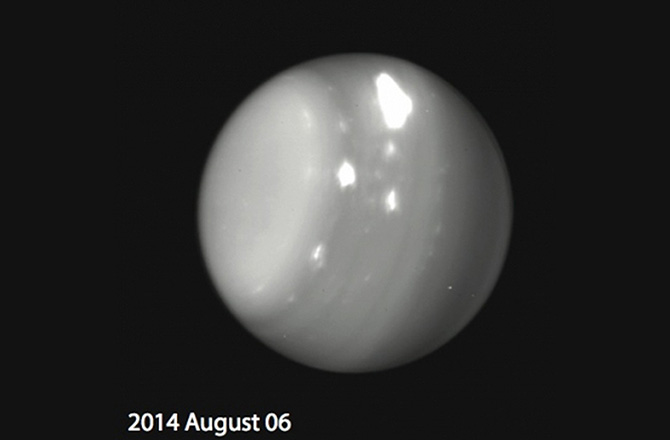
As hurricanes take aim at Hawaii, astronomers in Hawaii aimed their telescopes at storms raging on another planet: distant Uranus, the tilted ice giant orbiting the sun nearly 20 times farther away than Earth.
Wrapped in an atmosphere tinted pale blue by high-altitude methane, Uranus has occasionally been observed to develop large storms in its frigid windy skies. NASA's Voyager 2 saw a few small storm clouds spotting Uranus during its flyby in Jan. 1986, and more recently some large but short-lived storms were observed by Hubble and the W.M. Keck Observatory as the planet moved toward its equinox in 2007. Now, seven years after its equinox, swirling storms are once again blooming on Uranus - and Keck astronomers have caught them on camera.
It's not just one storm, either; several have appeared in infrared images of Uranus, including one enormous storm that's even bigger than a previously-observed giant that was nicknamed "Berg" because of its resemblance to an iceberg drifting through polar seas.
Berg had been watched by astronomers since before Uranus' 2007 equinox and it may have even dated back to the Voyager 2 visit. After migrating around the planet and changing in size and strength several times, Berg dissipated in 2009.
The biggest of the new storms is even larger than Berg, likely extending high into the planet's troposphere, and could become a similarly long-lived feature on Uranus.
"Even after years of observing, a new picture of Uranus from Keck Observatory can stop me in my tracks and make me say Wow!," said Heidi Hammel, a member of the observing team.
So even though it doesn't get mentioned all that often, Uranus can still hold a few surprises! (And please re-read the first sentence.)
Discovered in 1781, Uranus is the seventh planet in our solar system. At the time of the Keck observations Uranus was 19.51 AU away, which equates to a little over 1.813 billion miles (2.9 billion km). It orbits the sun once every 84 years.

Source: W.M. Keck Observatory



Drop the Raspberries, and back slowly away.
It's pronounced (according to Carl Sagan) yur'-ahn-us.
The last time I heard somene using the Your-a-nus gag was a sloppy drunk at the Shingletown Star Party public night, and he almost trashed a 32" Dob.